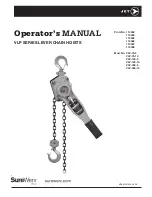
8
4
Allowing the load to bear against the hook latch
and/or hook tip can result in loss of load.
TO AVOID INJURY:
Do not allow the load to bear against the hook latch
and/or hook tip. Apply load to hook bowl or saddle only.
13. Never operate the hoist when flammable materials
or vapors are present. Sharp contact between metal parts
can produce sparks that can cause a fire or explosion.
14. STAY ALERT! Watch what you are doing and use common
sense. Do not use the hoist when you are tired, distracted
or under the influence of drugs, alcohol or medication
causing diminished control.
MAINTENANCE
INSPECTION
To maintain continuous and satisfactory operation, a regular
inspection procedure must be initiated so that worn or damaged
parts can be replaced before they become unsafe. The intervals
of inspection must be determined by the individual application
and are based upon the type of service to which the hoist will
be subjected. The inspection of hoists is divided into two general
classifications designated as “frequent” and “periodic.”
Frequent Inspections:
These inspections are visual examinations by the operator
or other designated personnel. The frequent inspections
are to be performed daily and shall include the following items:
a. Braking mechanisms for evidence of slippage daily.
b. Load Chain for lubricant, wear, damaged links
or foreign material-daily (See LOAD CHAIN, page 5).
Any deficiencies noted are to be corrected before the hoist
is returned to service.
Periodic Inspections:
These are inspections by an appointed person who makes
records of apparent external conditions to provide the basis
for a continuing evaluation. For normal service, the periodic
inspections are to be performed yearly and for heavy service,
the periodic inspections are to be performed semi-annually.
Due to the construction of the hoist, it will be necessary
to partially disassemble the unit to perform the periodic
inspections. The periodic inspections are to include those items
listed under frequent inspections as well as the following:
a. Chain for excessive wear or stretch (See page 5).
b. Worn, cracked or distorted parts such as hook
blocks, hand chain guides, chain guide, stripper,
loose end connector, shafts, gears, bushings
and bearings.
c. Inspect for wear on the tip of the driver, stops on
handwheel and pockets of the liftwheel and handwheel.
d. Loose or missing screws, nuts, pins or cotter pins.
e. Inspect brake components for worn, glazed or con-
taminated brake disc and scoring of the brake hub
and brake plate. If the thickness of the friction
washer is less than 1/32 inch, it should be replaced.
f. Replace missing or damaged warning labels.
g. Corroded, stretched or broken brake spring.
h. Hooks-dye penetrant, magnetic particle or other
suitable crack-detecting inspections should be per-
formed at least once a year, if external conditions
indicate there has been unusual usage.
Any deficiencies noted are to be corrected before the hoist
is returned to service. Also, the external conditions may show
the need for more detailed inspection which, in turn, may require
the use of nondestructive-type testing.
Any parts that are deemed unserviceable are to be replaced
with new CM
®
parts before the unit is returned to service.
It is very important that the unserviceable parts be destroyed
to prevent possible future use as a repair item and properly
disposed of.
Hook Inspection
Hooks damaged from chemicals, deformation or cracks,
or that have more than a 10
o
twist from the plane of the
unbent hook, excessive opening or seat wear, must be
replaced. Also, hooks that are opened to the extent that
the latch does not engage the tip must be replaced.
Any hook that is twisted or has excessive throat opening
indicated abuse or overloading of the hoist. Other load
sustaining parts should be inspected for damage.
Check to assure the latch is not damaged or bent and that
it operates properly. It should have sufficient spring pressure
to keep it tightly against the tip of the hook and allow
it to spring back to the tip when released. If the latch does
4not operate properly, replace the latch.
Replace hook if opening is greater than “C” or if the thickness
1/2
0.602
0.496
1.039
0.390
0.213
1
0.780
0.673
1.256
0.531
0.230
2
1.063
0.780
1.516
0.670
0.319
3
1.346
1.063
1.732
0.769
0.349
5
1.594
1.311
2.035
1.102
0.472
10
2.409
1.772
2.945
1.378
0.669
Figure 3 - Hook Inspection
H
oist
Critical Hook Dimensions (in.)
Capacity
(tons)
A
B
C
D
E
Содержание 5623A
Страница 15: ...15 11 NOTES...
Страница 17: ...17 13 CM HURRICANE 360 HAND HOIST EXPLODED VIEW...
Страница 46: ...46 NOTES NOTAS NOTES...
Страница 47: ...47 NOTES NOTAS NOTES...


























